Financial Performance Management Report: Environmental Cost Analysis
VerifiedAdded on 2023/01/05
|10
|3415
|84
Report
AI Summary
This report delves into financial performance management, emphasizing environmental cost accounting (EMA). It begins by defining financial performance management and EMA, then explores issues businesses face in managing environmental costs and the methods used for accounting. Part 1 covers environmental costs, including material costs, waste management, and less tangible costs, as well as the use of cost-benefit analysis. It highlights techniques for environmental expense detection and distribution, and the importance of controlling environmental costs. Part 2 focuses on management accounting planning tools for solving financial problems, such as cost-benefit analysis, planning, and KPIs. The report also covers benchmarking and financial governance, providing a comprehensive overview of financial performance management and environmental considerations for achieving financial sustainability.
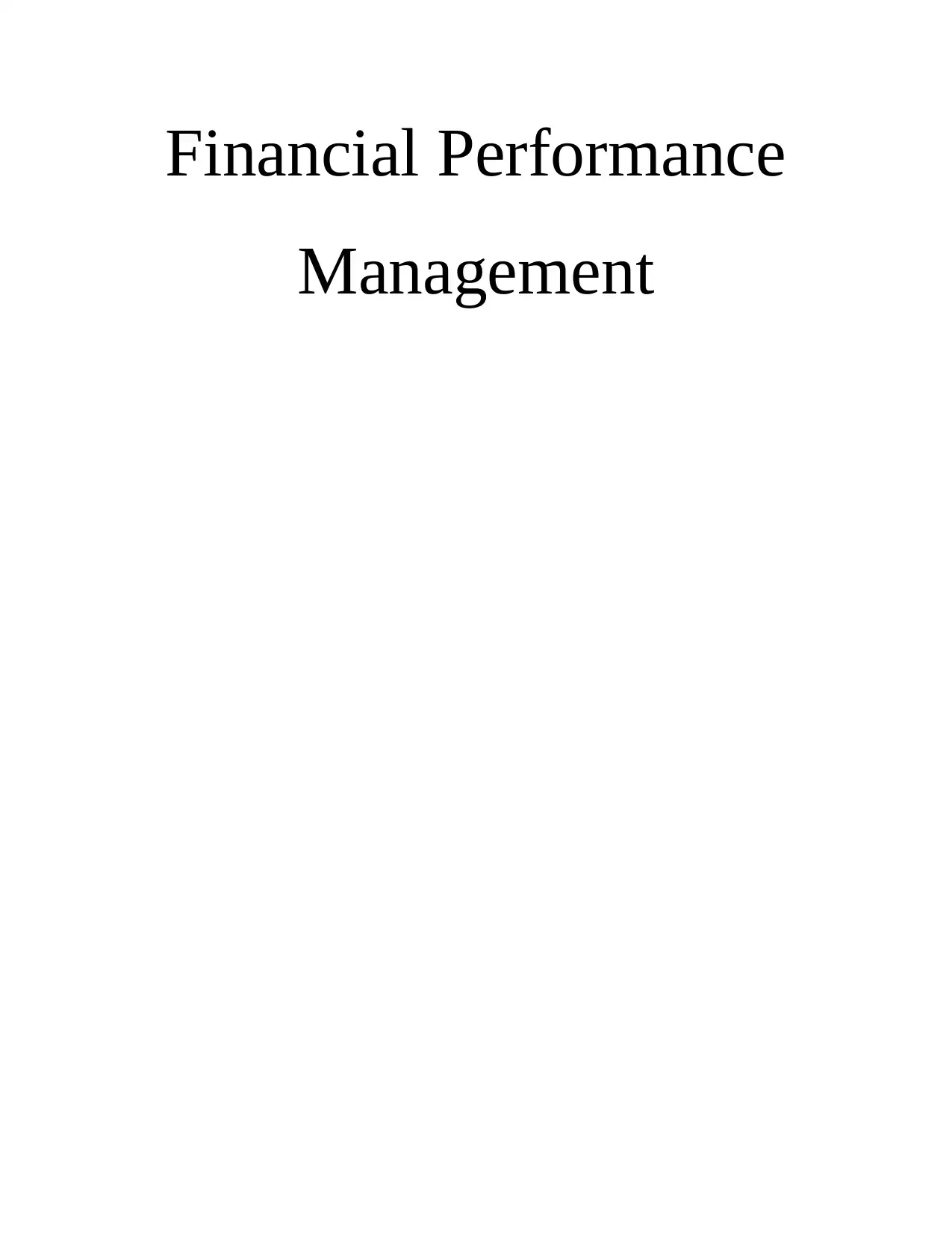
Financial Performance
Management
Management
Paraphrase This Document
Need a fresh take? Get an instant paraphrase of this document with our AI Paraphraser
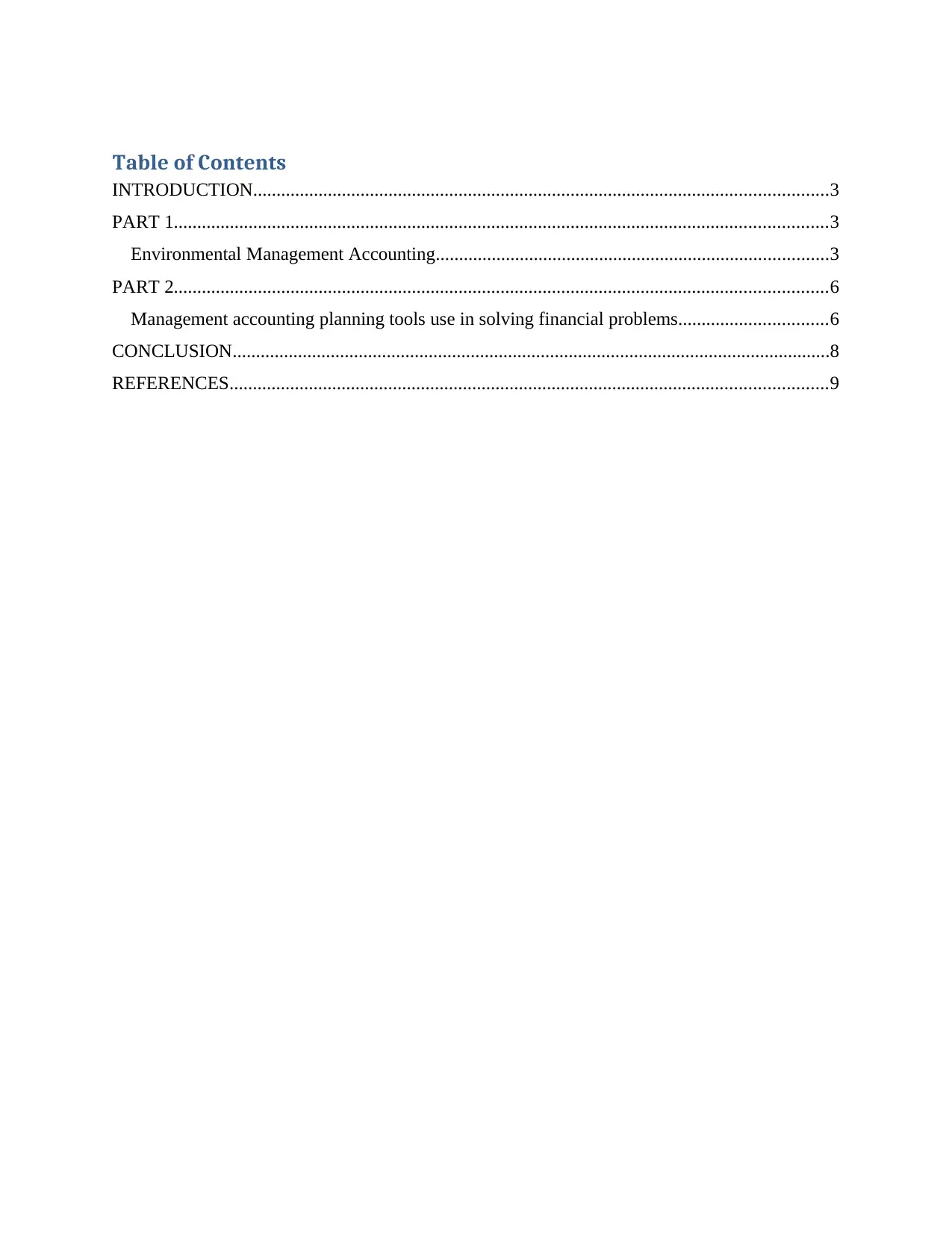
Table of Contents
INTRODUCTION...........................................................................................................................3
PART 1............................................................................................................................................3
Environmental Management Accounting....................................................................................3
PART 2............................................................................................................................................6
Management accounting planning tools use in solving financial problems................................6
CONCLUSION................................................................................................................................8
REFERENCES................................................................................................................................9
INTRODUCTION...........................................................................................................................3
PART 1............................................................................................................................................3
Environmental Management Accounting....................................................................................3
PART 2............................................................................................................................................6
Management accounting planning tools use in solving financial problems................................6
CONCLUSION................................................................................................................................8
REFERENCES................................................................................................................................9
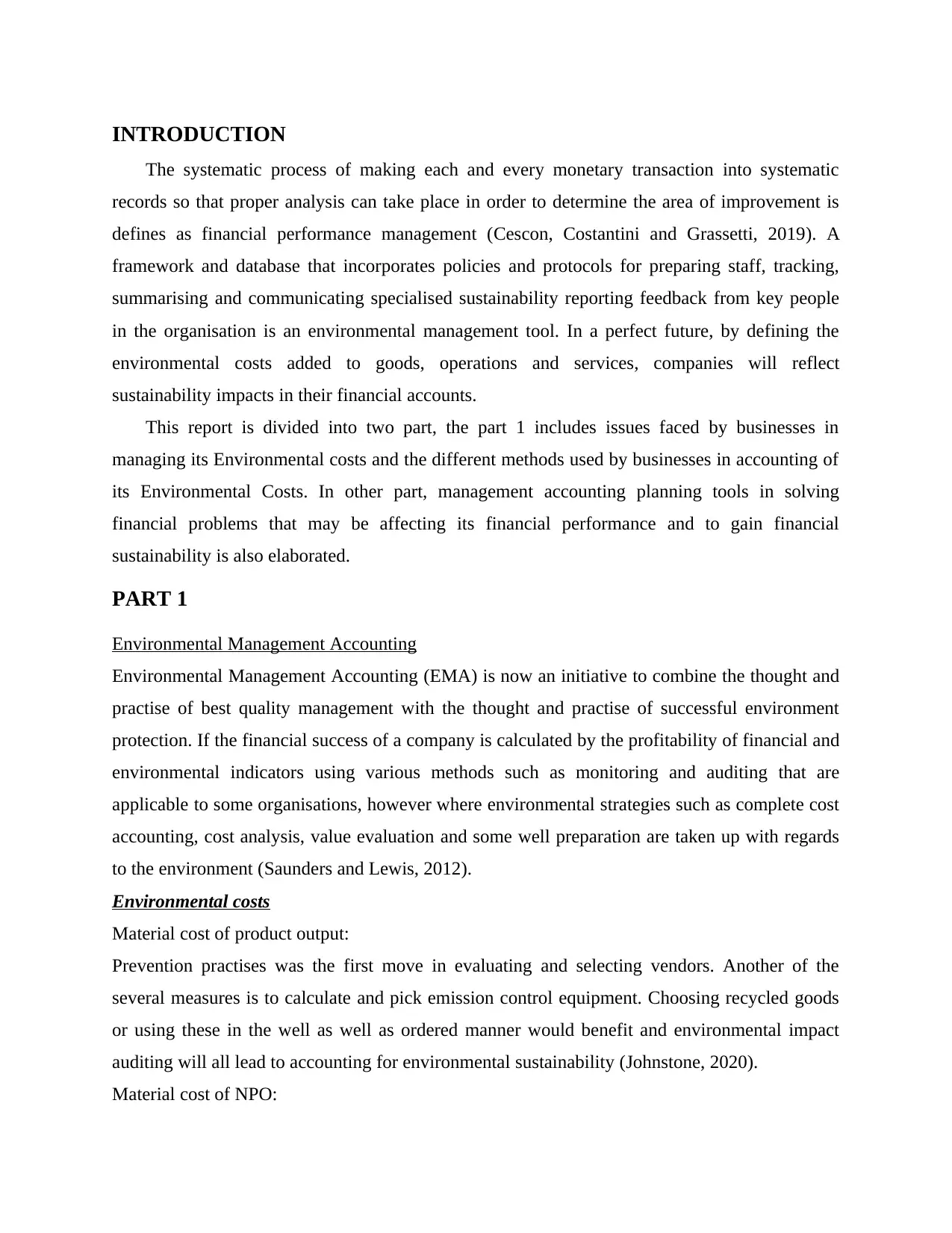
INTRODUCTION
The systematic process of making each and every monetary transaction into systematic
records so that proper analysis can take place in order to determine the area of improvement is
defines as financial performance management (Cescon, Costantini and Grassetti, 2019). A
framework and database that incorporates policies and protocols for preparing staff, tracking,
summarising and communicating specialised sustainability reporting feedback from key people
in the organisation is an environmental management tool. In a perfect future, by defining the
environmental costs added to goods, operations and services, companies will reflect
sustainability impacts in their financial accounts.
This report is divided into two part, the part 1 includes issues faced by businesses in
managing its Environmental costs and the different methods used by businesses in accounting of
its Environmental Costs. In other part, management accounting planning tools in solving
financial problems that may be affecting its financial performance and to gain financial
sustainability is also elaborated.
PART 1
Environmental Management Accounting
Environmental Management Accounting (EMA) is now an initiative to combine the thought and
practise of best quality management with the thought and practise of successful environment
protection. If the financial success of a company is calculated by the profitability of financial and
environmental indicators using various methods such as monitoring and auditing that are
applicable to some organisations, however where environmental strategies such as complete cost
accounting, cost analysis, value evaluation and some well preparation are taken up with regards
to the environment (Saunders and Lewis, 2012).
Environmental costs
Material cost of product output:
Prevention practises was the first move in evaluating and selecting vendors. Another of the
several measures is to calculate and pick emission control equipment. Choosing recycled goods
or using these in the well as well as ordered manner would benefit and environmental impact
auditing will all lead to accounting for environmental sustainability (Johnstone, 2020).
Material cost of NPO:
The systematic process of making each and every monetary transaction into systematic
records so that proper analysis can take place in order to determine the area of improvement is
defines as financial performance management (Cescon, Costantini and Grassetti, 2019). A
framework and database that incorporates policies and protocols for preparing staff, tracking,
summarising and communicating specialised sustainability reporting feedback from key people
in the organisation is an environmental management tool. In a perfect future, by defining the
environmental costs added to goods, operations and services, companies will reflect
sustainability impacts in their financial accounts.
This report is divided into two part, the part 1 includes issues faced by businesses in
managing its Environmental costs and the different methods used by businesses in accounting of
its Environmental Costs. In other part, management accounting planning tools in solving
financial problems that may be affecting its financial performance and to gain financial
sustainability is also elaborated.
PART 1
Environmental Management Accounting
Environmental Management Accounting (EMA) is now an initiative to combine the thought and
practise of best quality management with the thought and practise of successful environment
protection. If the financial success of a company is calculated by the profitability of financial and
environmental indicators using various methods such as monitoring and auditing that are
applicable to some organisations, however where environmental strategies such as complete cost
accounting, cost analysis, value evaluation and some well preparation are taken up with regards
to the environment (Saunders and Lewis, 2012).
Environmental costs
Material cost of product output:
Prevention practises was the first move in evaluating and selecting vendors. Another of the
several measures is to calculate and pick emission control equipment. Choosing recycled goods
or using these in the well as well as ordered manner would benefit and environmental impact
auditing will all lead to accounting for environmental sustainability (Johnstone, 2020).
Material cost of NPO:
⊘ This is a preview!⊘
Do you want full access?
Subscribe today to unlock all pages.

Trusted by 1+ million students worldwide
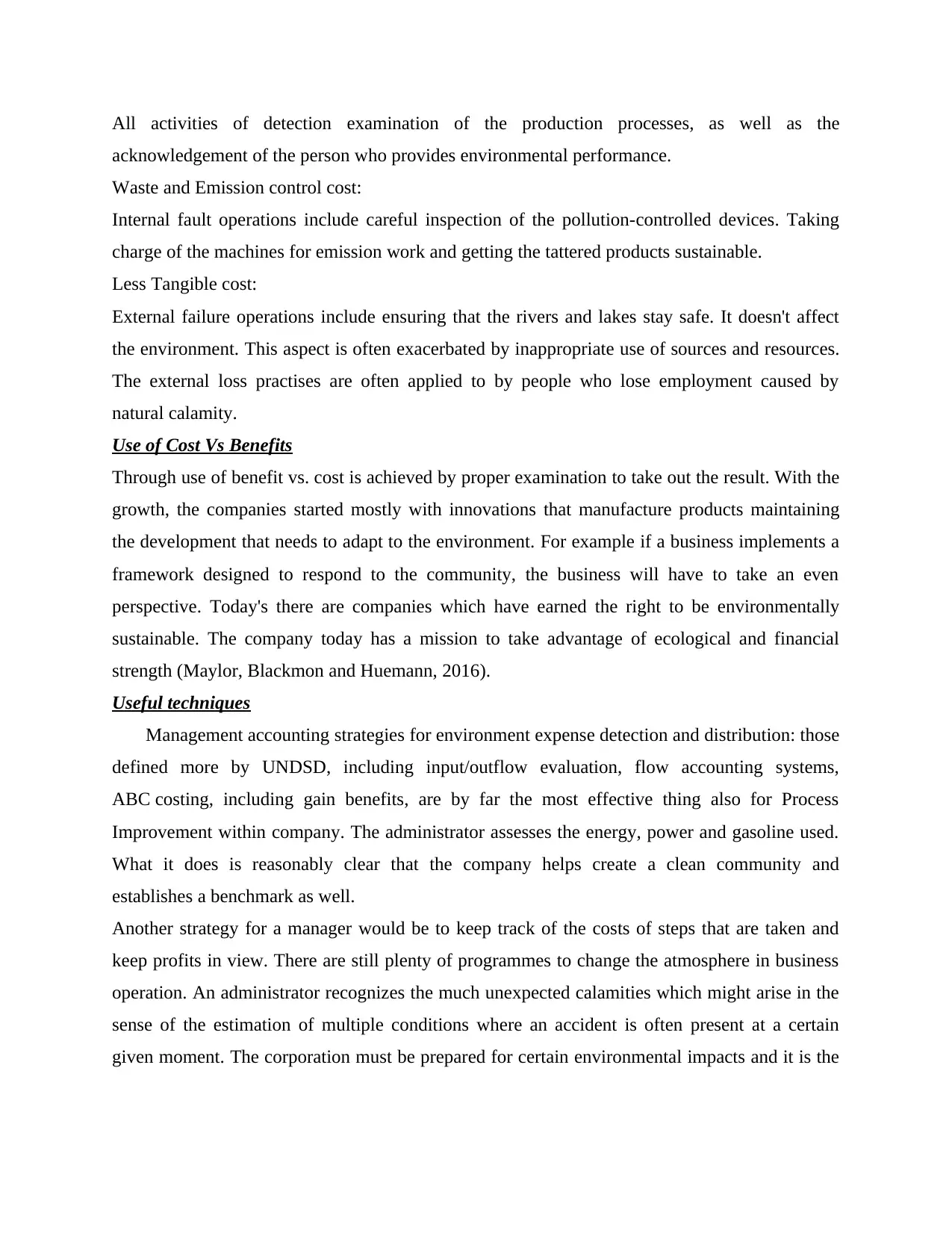
All activities of detection examination of the production processes, as well as the
acknowledgement of the person who provides environmental performance.
Waste and Emission control cost:
Internal fault operations include careful inspection of the pollution-controlled devices. Taking
charge of the machines for emission work and getting the tattered products sustainable.
Less Tangible cost:
External failure operations include ensuring that the rivers and lakes stay safe. It doesn't affect
the environment. This aspect is often exacerbated by inappropriate use of sources and resources.
The external loss practises are often applied to by people who lose employment caused by
natural calamity.
Use of Cost Vs Benefits
Through use of benefit vs. cost is achieved by proper examination to take out the result. With the
growth, the companies started mostly with innovations that manufacture products maintaining
the development that needs to adapt to the environment. For example if a business implements a
framework designed to respond to the community, the business will have to take an even
perspective. Today's there are companies which have earned the right to be environmentally
sustainable. The company today has a mission to take advantage of ecological and financial
strength (Maylor, Blackmon and Huemann, 2016).
Useful techniques
Management accounting strategies for environment expense detection and distribution: those
defined more by UNDSD, including input/outflow evaluation, flow accounting systems,
ABC costing, including gain benefits, are by far the most effective thing also for Process
Improvement within company. The administrator assesses the energy, power and gasoline used.
What it does is reasonably clear that the company helps create a clean community and
establishes a benchmark as well.
Another strategy for a manager would be to keep track of the costs of steps that are taken and
keep profits in view. There are still plenty of programmes to change the atmosphere in business
operation. An administrator recognizes the much unexpected calamities which might arise in the
sense of the estimation of multiple conditions where an accident is often present at a certain
given moment. The corporation must be prepared for certain environmental impacts and it is the
acknowledgement of the person who provides environmental performance.
Waste and Emission control cost:
Internal fault operations include careful inspection of the pollution-controlled devices. Taking
charge of the machines for emission work and getting the tattered products sustainable.
Less Tangible cost:
External failure operations include ensuring that the rivers and lakes stay safe. It doesn't affect
the environment. This aspect is often exacerbated by inappropriate use of sources and resources.
The external loss practises are often applied to by people who lose employment caused by
natural calamity.
Use of Cost Vs Benefits
Through use of benefit vs. cost is achieved by proper examination to take out the result. With the
growth, the companies started mostly with innovations that manufacture products maintaining
the development that needs to adapt to the environment. For example if a business implements a
framework designed to respond to the community, the business will have to take an even
perspective. Today's there are companies which have earned the right to be environmentally
sustainable. The company today has a mission to take advantage of ecological and financial
strength (Maylor, Blackmon and Huemann, 2016).
Useful techniques
Management accounting strategies for environment expense detection and distribution: those
defined more by UNDSD, including input/outflow evaluation, flow accounting systems,
ABC costing, including gain benefits, are by far the most effective thing also for Process
Improvement within company. The administrator assesses the energy, power and gasoline used.
What it does is reasonably clear that the company helps create a clean community and
establishes a benchmark as well.
Another strategy for a manager would be to keep track of the costs of steps that are taken and
keep profits in view. There are still plenty of programmes to change the atmosphere in business
operation. An administrator recognizes the much unexpected calamities which might arise in the
sense of the estimation of multiple conditions where an accident is often present at a certain
given moment. The corporation must be prepared for certain environmental impacts and it is the
Paraphrase This Document
Need a fresh take? Get an instant paraphrase of this document with our AI Paraphraser
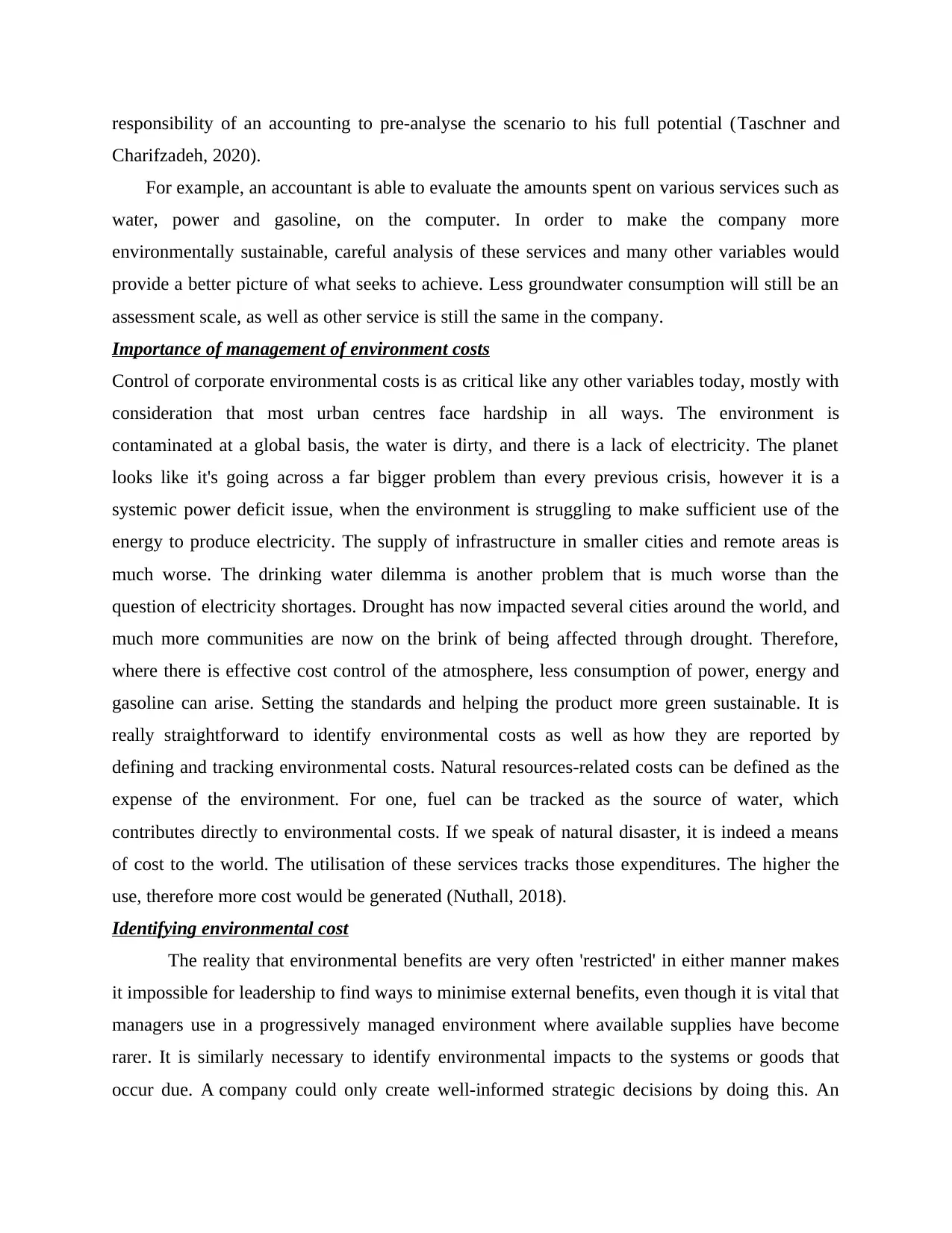
responsibility of an accounting to pre-analyse the scenario to his full potential (Taschner and
Charifzadeh, 2020).
For example, an accountant is able to evaluate the amounts spent on various services such as
water, power and gasoline, on the computer. In order to make the company more
environmentally sustainable, careful analysis of these services and many other variables would
provide a better picture of what seeks to achieve. Less groundwater consumption will still be an
assessment scale, as well as other service is still the same in the company.
Importance of management of environment costs
Control of corporate environmental costs is as critical like any other variables today, mostly with
consideration that most urban centres face hardship in all ways. The environment is
contaminated at a global basis, the water is dirty, and there is a lack of electricity. The planet
looks like it's going across a far bigger problem than every previous crisis, however it is a
systemic power deficit issue, when the environment is struggling to make sufficient use of the
energy to produce electricity. The supply of infrastructure in smaller cities and remote areas is
much worse. The drinking water dilemma is another problem that is much worse than the
question of electricity shortages. Drought has now impacted several cities around the world, and
much more communities are now on the brink of being affected through drought. Therefore,
where there is effective cost control of the atmosphere, less consumption of power, energy and
gasoline can arise. Setting the standards and helping the product more green sustainable. It is
really straightforward to identify environmental costs as well as how they are reported by
defining and tracking environmental costs. Natural resources-related costs can be defined as the
expense of the environment. For one, fuel can be tracked as the source of water, which
contributes directly to environmental costs. If we speak of natural disaster, it is indeed a means
of cost to the world. The utilisation of these services tracks those expenditures. The higher the
use, therefore more cost would be generated (Nuthall, 2018).
Identifying environmental cost
The reality that environmental benefits are very often 'restricted' in either manner makes
it impossible for leadership to find ways to minimise external benefits, even though it is vital that
managers use in a progressively managed environment where available supplies have become
rarer. It is similarly necessary to identify environmental impacts to the systems or goods that
occur due. A company could only create well-informed strategic decisions by doing this. An
Charifzadeh, 2020).
For example, an accountant is able to evaluate the amounts spent on various services such as
water, power and gasoline, on the computer. In order to make the company more
environmentally sustainable, careful analysis of these services and many other variables would
provide a better picture of what seeks to achieve. Less groundwater consumption will still be an
assessment scale, as well as other service is still the same in the company.
Importance of management of environment costs
Control of corporate environmental costs is as critical like any other variables today, mostly with
consideration that most urban centres face hardship in all ways. The environment is
contaminated at a global basis, the water is dirty, and there is a lack of electricity. The planet
looks like it's going across a far bigger problem than every previous crisis, however it is a
systemic power deficit issue, when the environment is struggling to make sufficient use of the
energy to produce electricity. The supply of infrastructure in smaller cities and remote areas is
much worse. The drinking water dilemma is another problem that is much worse than the
question of electricity shortages. Drought has now impacted several cities around the world, and
much more communities are now on the brink of being affected through drought. Therefore,
where there is effective cost control of the atmosphere, less consumption of power, energy and
gasoline can arise. Setting the standards and helping the product more green sustainable. It is
really straightforward to identify environmental costs as well as how they are reported by
defining and tracking environmental costs. Natural resources-related costs can be defined as the
expense of the environment. For one, fuel can be tracked as the source of water, which
contributes directly to environmental costs. If we speak of natural disaster, it is indeed a means
of cost to the world. The utilisation of these services tracks those expenditures. The higher the
use, therefore more cost would be generated (Nuthall, 2018).
Identifying environmental cost
The reality that environmental benefits are very often 'restricted' in either manner makes
it impossible for leadership to find ways to minimise external benefits, even though it is vital that
managers use in a progressively managed environment where available supplies have become
rarer. It is similarly necessary to identify environmental impacts to the systems or goods that
occur due. A company could only create well-informed strategic decisions by doing this. An
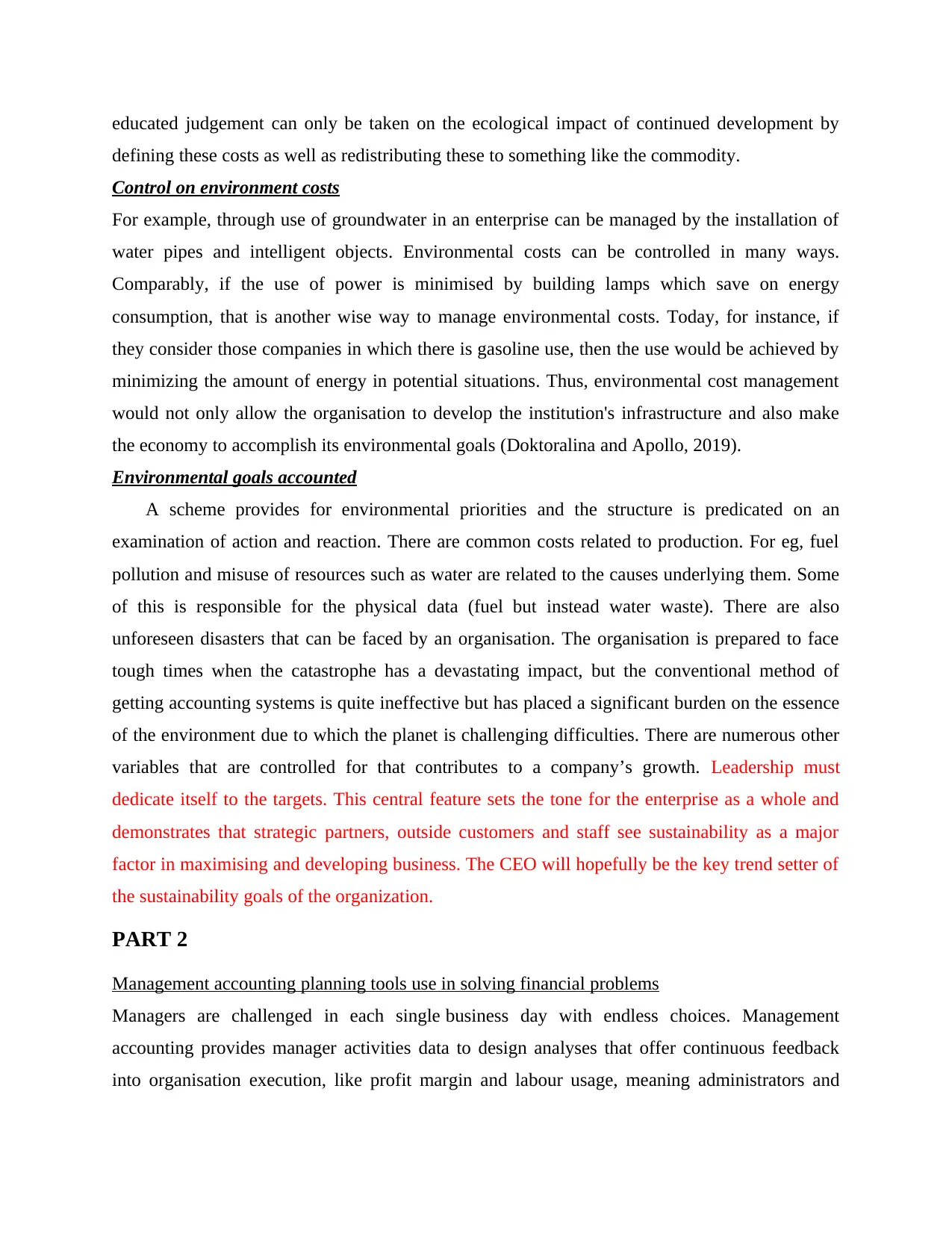
educated judgement can only be taken on the ecological impact of continued development by
defining these costs as well as redistributing these to something like the commodity.
Control on environment costs
For example, through use of groundwater in an enterprise can be managed by the installation of
water pipes and intelligent objects. Environmental costs can be controlled in many ways.
Comparably, if the use of power is minimised by building lamps which save on energy
consumption, that is another wise way to manage environmental costs. Today, for instance, if
they consider those companies in which there is gasoline use, then the use would be achieved by
minimizing the amount of energy in potential situations. Thus, environmental cost management
would not only allow the organisation to develop the institution's infrastructure and also make
the economy to accomplish its environmental goals (Doktoralina and Apollo, 2019).
Environmental goals accounted
A scheme provides for environmental priorities and the structure is predicated on an
examination of action and reaction. There are common costs related to production. For eg, fuel
pollution and misuse of resources such as water are related to the causes underlying them. Some
of this is responsible for the physical data (fuel but instead water waste). There are also
unforeseen disasters that can be faced by an organisation. The organisation is prepared to face
tough times when the catastrophe has a devastating impact, but the conventional method of
getting accounting systems is quite ineffective but has placed a significant burden on the essence
of the environment due to which the planet is challenging difficulties. There are numerous other
variables that are controlled for that contributes to a company’s growth. Leadership must
dedicate itself to the targets. This central feature sets the tone for the enterprise as a whole and
demonstrates that strategic partners, outside customers and staff see sustainability as a major
factor in maximising and developing business. The CEO will hopefully be the key trend setter of
the sustainability goals of the organization.
PART 2
Management accounting planning tools use in solving financial problems
Managers are challenged in each single business day with endless choices. Management
accounting provides manager activities data to design analyses that offer continuous feedback
into organisation execution, like profit margin and labour usage, meaning administrators and
defining these costs as well as redistributing these to something like the commodity.
Control on environment costs
For example, through use of groundwater in an enterprise can be managed by the installation of
water pipes and intelligent objects. Environmental costs can be controlled in many ways.
Comparably, if the use of power is minimised by building lamps which save on energy
consumption, that is another wise way to manage environmental costs. Today, for instance, if
they consider those companies in which there is gasoline use, then the use would be achieved by
minimizing the amount of energy in potential situations. Thus, environmental cost management
would not only allow the organisation to develop the institution's infrastructure and also make
the economy to accomplish its environmental goals (Doktoralina and Apollo, 2019).
Environmental goals accounted
A scheme provides for environmental priorities and the structure is predicated on an
examination of action and reaction. There are common costs related to production. For eg, fuel
pollution and misuse of resources such as water are related to the causes underlying them. Some
of this is responsible for the physical data (fuel but instead water waste). There are also
unforeseen disasters that can be faced by an organisation. The organisation is prepared to face
tough times when the catastrophe has a devastating impact, but the conventional method of
getting accounting systems is quite ineffective but has placed a significant burden on the essence
of the environment due to which the planet is challenging difficulties. There are numerous other
variables that are controlled for that contributes to a company’s growth. Leadership must
dedicate itself to the targets. This central feature sets the tone for the enterprise as a whole and
demonstrates that strategic partners, outside customers and staff see sustainability as a major
factor in maximising and developing business. The CEO will hopefully be the key trend setter of
the sustainability goals of the organization.
PART 2
Management accounting planning tools use in solving financial problems
Managers are challenged in each single business day with endless choices. Management
accounting provides manager activities data to design analyses that offer continuous feedback
into organisation execution, like profit margin and labour usage, meaning administrators and
⊘ This is a preview!⊘
Do you want full access?
Subscribe today to unlock all pages.

Trusted by 1+ million students worldwide
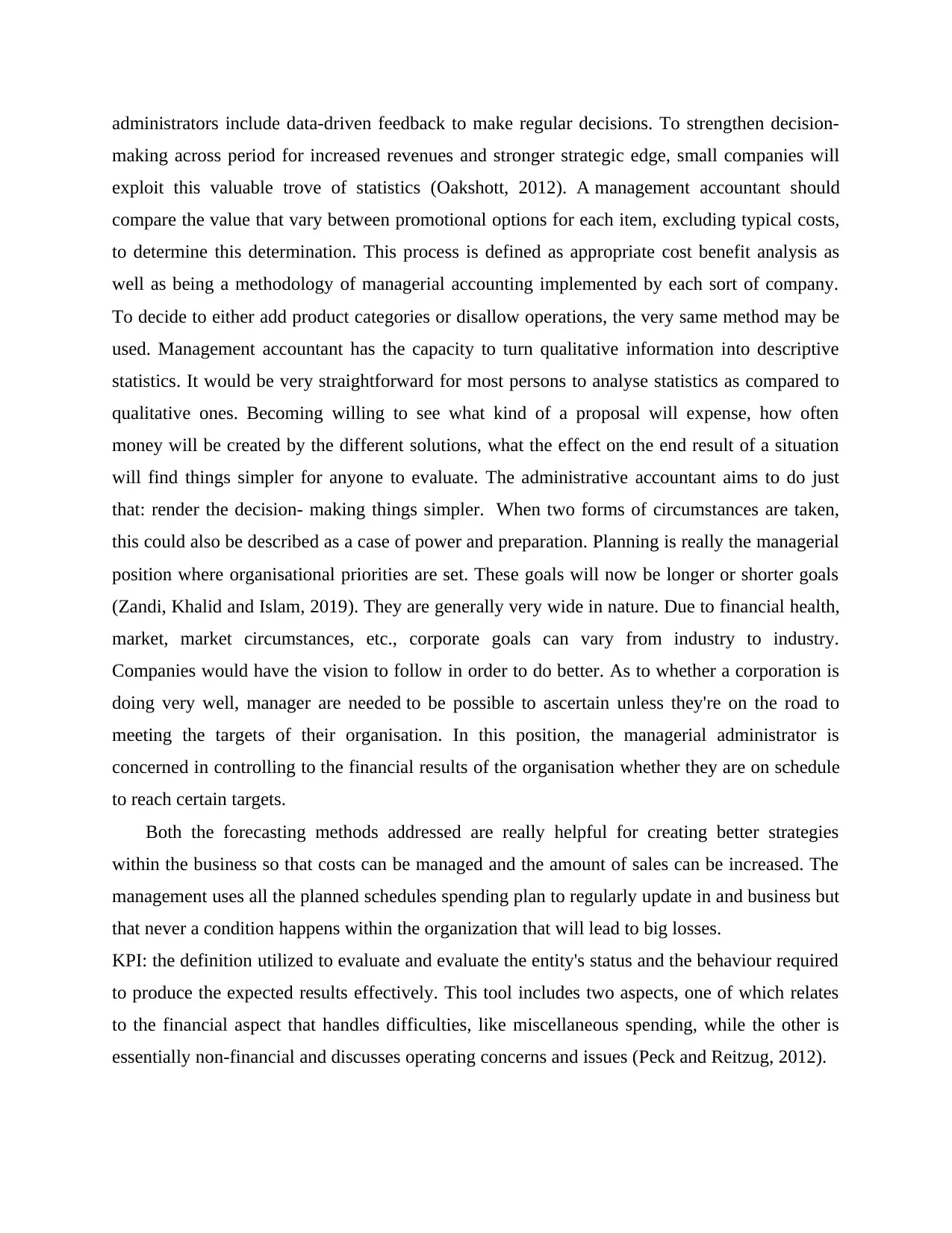
administrators include data-driven feedback to make regular decisions. To strengthen decision-
making across period for increased revenues and stronger strategic edge, small companies will
exploit this valuable trove of statistics (Oakshott, 2012). A management accountant should
compare the value that vary between promotional options for each item, excluding typical costs,
to determine this determination. This process is defined as appropriate cost benefit analysis as
well as being a methodology of managerial accounting implemented by each sort of company.
To decide to either add product categories or disallow operations, the very same method may be
used. Management accountant has the capacity to turn qualitative information into descriptive
statistics. It would be very straightforward for most persons to analyse statistics as compared to
qualitative ones. Becoming willing to see what kind of a proposal will expense, how often
money will be created by the different solutions, what the effect on the end result of a situation
will find things simpler for anyone to evaluate. The administrative accountant aims to do just
that: render the decision- making things simpler. When two forms of circumstances are taken,
this could also be described as a case of power and preparation. Planning is really the managerial
position where organisational priorities are set. These goals will now be longer or shorter goals
(Zandi, Khalid and Islam, 2019). They are generally very wide in nature. Due to financial health,
market, market circumstances, etc., corporate goals can vary from industry to industry.
Companies would have the vision to follow in order to do better. As to whether a corporation is
doing very well, manager are needed to be possible to ascertain unless they're on the road to
meeting the targets of their organisation. In this position, the managerial administrator is
concerned in controlling to the financial results of the organisation whether they are on schedule
to reach certain targets.
Both the forecasting methods addressed are really helpful for creating better strategies
within the business so that costs can be managed and the amount of sales can be increased. The
management uses all the planned schedules spending plan to regularly update in and business but
that never a condition happens within the organization that will lead to big losses.
KPI: the definition utilized to evaluate and evaluate the entity's status and the behaviour required
to produce the expected results effectively. This tool includes two aspects, one of which relates
to the financial aspect that handles difficulties, like miscellaneous spending, while the other is
essentially non-financial and discusses operating concerns and issues (Peck and Reitzug, 2012).
making across period for increased revenues and stronger strategic edge, small companies will
exploit this valuable trove of statistics (Oakshott, 2012). A management accountant should
compare the value that vary between promotional options for each item, excluding typical costs,
to determine this determination. This process is defined as appropriate cost benefit analysis as
well as being a methodology of managerial accounting implemented by each sort of company.
To decide to either add product categories or disallow operations, the very same method may be
used. Management accountant has the capacity to turn qualitative information into descriptive
statistics. It would be very straightforward for most persons to analyse statistics as compared to
qualitative ones. Becoming willing to see what kind of a proposal will expense, how often
money will be created by the different solutions, what the effect on the end result of a situation
will find things simpler for anyone to evaluate. The administrative accountant aims to do just
that: render the decision- making things simpler. When two forms of circumstances are taken,
this could also be described as a case of power and preparation. Planning is really the managerial
position where organisational priorities are set. These goals will now be longer or shorter goals
(Zandi, Khalid and Islam, 2019). They are generally very wide in nature. Due to financial health,
market, market circumstances, etc., corporate goals can vary from industry to industry.
Companies would have the vision to follow in order to do better. As to whether a corporation is
doing very well, manager are needed to be possible to ascertain unless they're on the road to
meeting the targets of their organisation. In this position, the managerial administrator is
concerned in controlling to the financial results of the organisation whether they are on schedule
to reach certain targets.
Both the forecasting methods addressed are really helpful for creating better strategies
within the business so that costs can be managed and the amount of sales can be increased. The
management uses all the planned schedules spending plan to regularly update in and business but
that never a condition happens within the organization that will lead to big losses.
KPI: the definition utilized to evaluate and evaluate the entity's status and the behaviour required
to produce the expected results effectively. This tool includes two aspects, one of which relates
to the financial aspect that handles difficulties, like miscellaneous spending, while the other is
essentially non-financial and discusses operating concerns and issues (Peck and Reitzug, 2012).
Paraphrase This Document
Need a fresh take? Get an instant paraphrase of this document with our AI Paraphraser
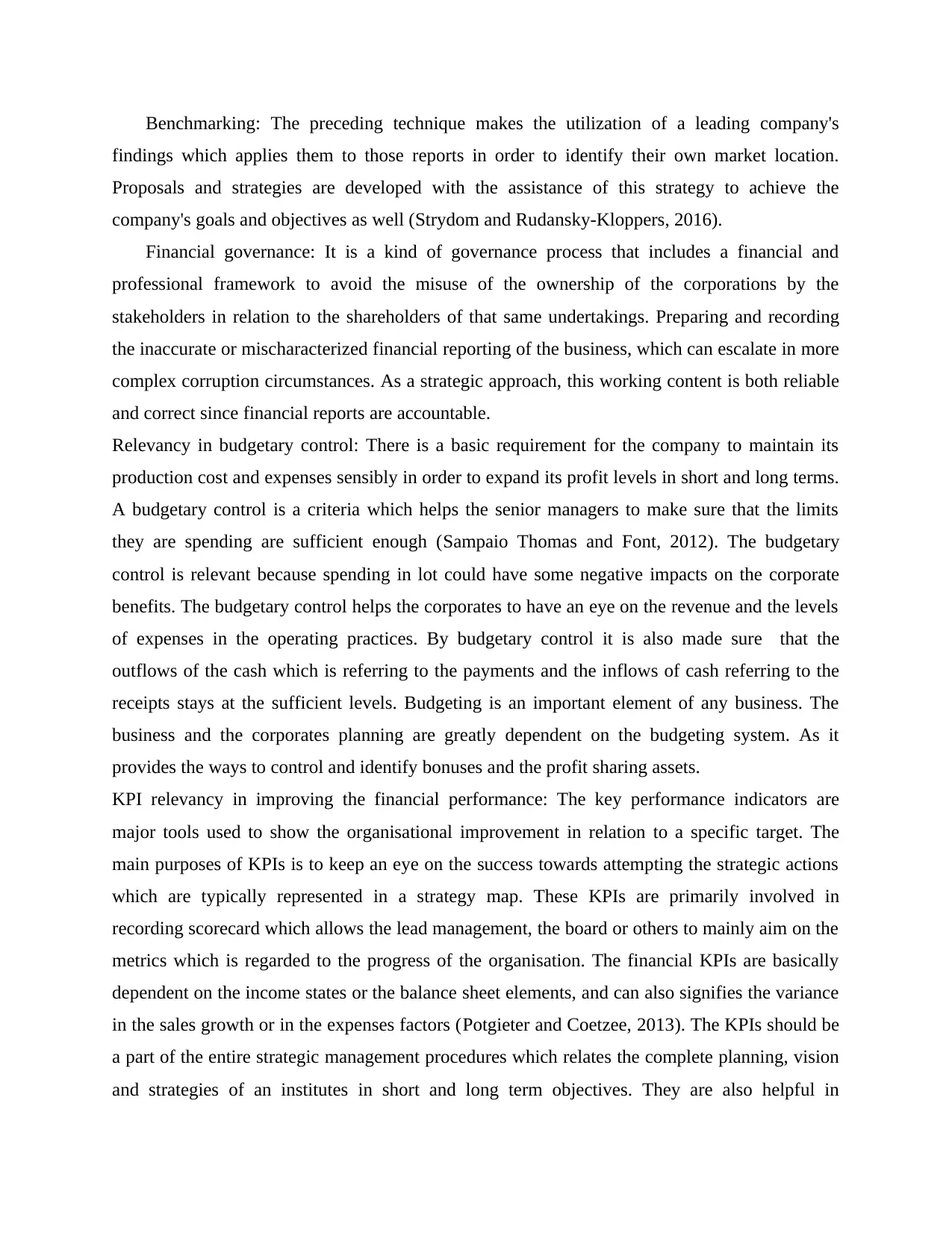
Benchmarking: The preceding technique makes the utilization of a leading company's
findings which applies them to those reports in order to identify their own market location.
Proposals and strategies are developed with the assistance of this strategy to achieve the
company's goals and objectives as well (Strydom and Rudansky-Kloppers, 2016).
Financial governance: It is a kind of governance process that includes a financial and
professional framework to avoid the misuse of the ownership of the corporations by the
stakeholders in relation to the shareholders of that same undertakings. Preparing and recording
the inaccurate or mischaracterized financial reporting of the business, which can escalate in more
complex corruption circumstances. As a strategic approach, this working content is both reliable
and correct since financial reports are accountable.
Relevancy in budgetary control: There is a basic requirement for the company to maintain its
production cost and expenses sensibly in order to expand its profit levels in short and long terms.
A budgetary control is a criteria which helps the senior managers to make sure that the limits
they are spending are sufficient enough (Sampaio Thomas and Font, 2012). The budgetary
control is relevant because spending in lot could have some negative impacts on the corporate
benefits. The budgetary control helps the corporates to have an eye on the revenue and the levels
of expenses in the operating practices. By budgetary control it is also made sure that the
outflows of the cash which is referring to the payments and the inflows of cash referring to the
receipts stays at the sufficient levels. Budgeting is an important element of any business. The
business and the corporates planning are greatly dependent on the budgeting system. As it
provides the ways to control and identify bonuses and the profit sharing assets.
KPI relevancy in improving the financial performance: The key performance indicators are
major tools used to show the organisational improvement in relation to a specific target. The
main purposes of KPIs is to keep an eye on the success towards attempting the strategic actions
which are typically represented in a strategy map. These KPIs are primarily involved in
recording scorecard which allows the lead management, the board or others to mainly aim on the
metrics which is regarded to the progress of the organisation. The financial KPIs are basically
dependent on the income states or the balance sheet elements, and can also signifies the variance
in the sales growth or in the expenses factors (Potgieter and Coetzee, 2013). The KPIs should be
a part of the entire strategic management procedures which relates the complete planning, vision
and strategies of an institutes in short and long term objectives. They are also helpful in
findings which applies them to those reports in order to identify their own market location.
Proposals and strategies are developed with the assistance of this strategy to achieve the
company's goals and objectives as well (Strydom and Rudansky-Kloppers, 2016).
Financial governance: It is a kind of governance process that includes a financial and
professional framework to avoid the misuse of the ownership of the corporations by the
stakeholders in relation to the shareholders of that same undertakings. Preparing and recording
the inaccurate or mischaracterized financial reporting of the business, which can escalate in more
complex corruption circumstances. As a strategic approach, this working content is both reliable
and correct since financial reports are accountable.
Relevancy in budgetary control: There is a basic requirement for the company to maintain its
production cost and expenses sensibly in order to expand its profit levels in short and long terms.
A budgetary control is a criteria which helps the senior managers to make sure that the limits
they are spending are sufficient enough (Sampaio Thomas and Font, 2012). The budgetary
control is relevant because spending in lot could have some negative impacts on the corporate
benefits. The budgetary control helps the corporates to have an eye on the revenue and the levels
of expenses in the operating practices. By budgetary control it is also made sure that the
outflows of the cash which is referring to the payments and the inflows of cash referring to the
receipts stays at the sufficient levels. Budgeting is an important element of any business. The
business and the corporates planning are greatly dependent on the budgeting system. As it
provides the ways to control and identify bonuses and the profit sharing assets.
KPI relevancy in improving the financial performance: The key performance indicators are
major tools used to show the organisational improvement in relation to a specific target. The
main purposes of KPIs is to keep an eye on the success towards attempting the strategic actions
which are typically represented in a strategy map. These KPIs are primarily involved in
recording scorecard which allows the lead management, the board or others to mainly aim on the
metrics which is regarded to the progress of the organisation. The financial KPIs are basically
dependent on the income states or the balance sheet elements, and can also signifies the variance
in the sales growth or in the expenses factors (Potgieter and Coetzee, 2013). The KPIs should be
a part of the entire strategic management procedures which relates the complete planning, vision
and strategies of an institutes in short and long term objectives. They are also helpful in
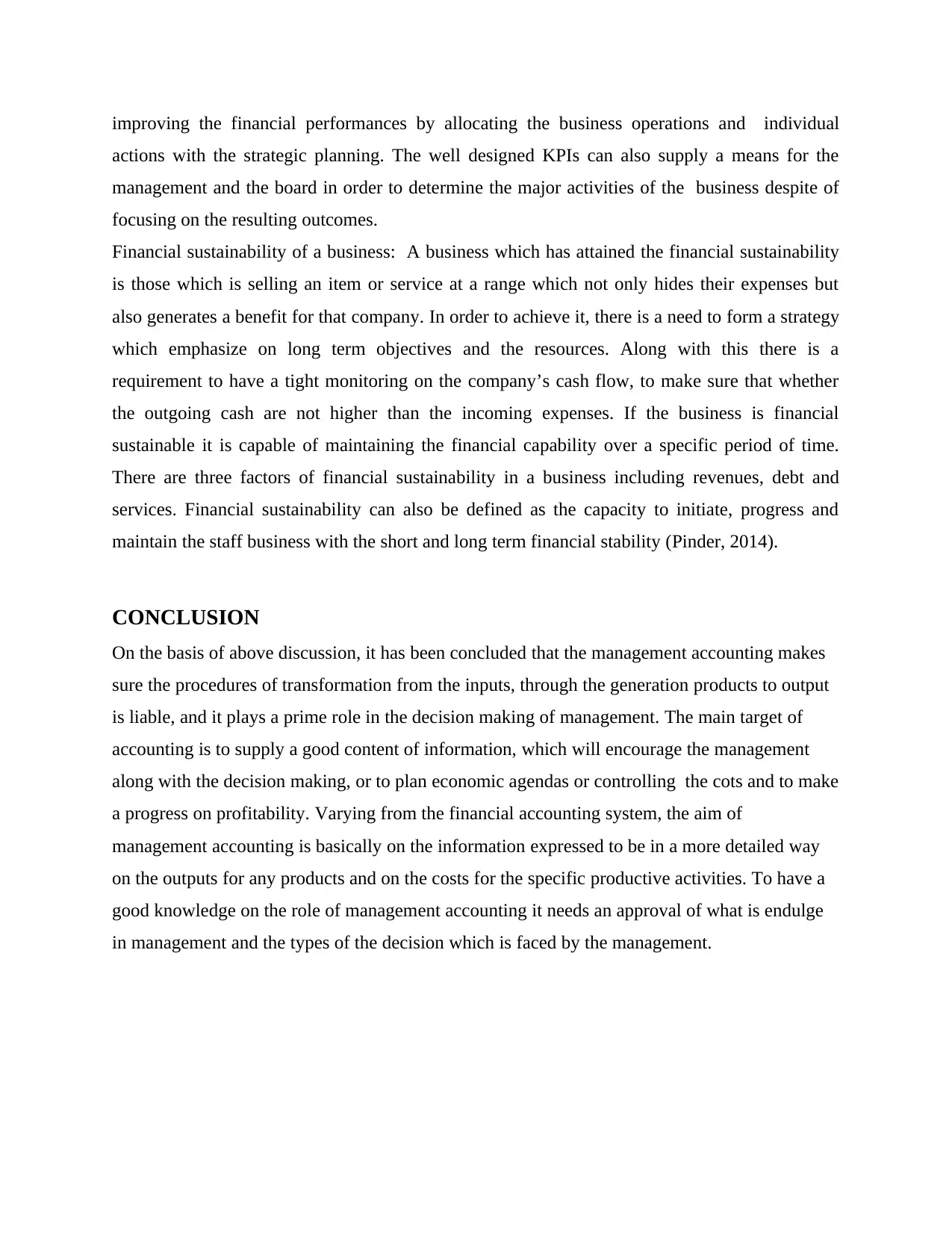
improving the financial performances by allocating the business operations and individual
actions with the strategic planning. The well designed KPIs can also supply a means for the
management and the board in order to determine the major activities of the business despite of
focusing on the resulting outcomes.
Financial sustainability of a business: A business which has attained the financial sustainability
is those which is selling an item or service at a range which not only hides their expenses but
also generates a benefit for that company. In order to achieve it, there is a need to form a strategy
which emphasize on long term objectives and the resources. Along with this there is a
requirement to have a tight monitoring on the company’s cash flow, to make sure that whether
the outgoing cash are not higher than the incoming expenses. If the business is financial
sustainable it is capable of maintaining the financial capability over a specific period of time.
There are three factors of financial sustainability in a business including revenues, debt and
services. Financial sustainability can also be defined as the capacity to initiate, progress and
maintain the staff business with the short and long term financial stability (Pinder, 2014).
CONCLUSION
On the basis of above discussion, it has been concluded that the management accounting makes
sure the procedures of transformation from the inputs, through the generation products to output
is liable, and it plays a prime role in the decision making of management. The main target of
accounting is to supply a good content of information, which will encourage the management
along with the decision making, or to plan economic agendas or controlling the cots and to make
a progress on profitability. Varying from the financial accounting system, the aim of
management accounting is basically on the information expressed to be in a more detailed way
on the outputs for any products and on the costs for the specific productive activities. To have a
good knowledge on the role of management accounting it needs an approval of what is endulge
in management and the types of the decision which is faced by the management.
actions with the strategic planning. The well designed KPIs can also supply a means for the
management and the board in order to determine the major activities of the business despite of
focusing on the resulting outcomes.
Financial sustainability of a business: A business which has attained the financial sustainability
is those which is selling an item or service at a range which not only hides their expenses but
also generates a benefit for that company. In order to achieve it, there is a need to form a strategy
which emphasize on long term objectives and the resources. Along with this there is a
requirement to have a tight monitoring on the company’s cash flow, to make sure that whether
the outgoing cash are not higher than the incoming expenses. If the business is financial
sustainable it is capable of maintaining the financial capability over a specific period of time.
There are three factors of financial sustainability in a business including revenues, debt and
services. Financial sustainability can also be defined as the capacity to initiate, progress and
maintain the staff business with the short and long term financial stability (Pinder, 2014).
CONCLUSION
On the basis of above discussion, it has been concluded that the management accounting makes
sure the procedures of transformation from the inputs, through the generation products to output
is liable, and it plays a prime role in the decision making of management. The main target of
accounting is to supply a good content of information, which will encourage the management
along with the decision making, or to plan economic agendas or controlling the cots and to make
a progress on profitability. Varying from the financial accounting system, the aim of
management accounting is basically on the information expressed to be in a more detailed way
on the outputs for any products and on the costs for the specific productive activities. To have a
good knowledge on the role of management accounting it needs an approval of what is endulge
in management and the types of the decision which is faced by the management.
⊘ This is a preview!⊘
Do you want full access?
Subscribe today to unlock all pages.

Trusted by 1+ million students worldwide
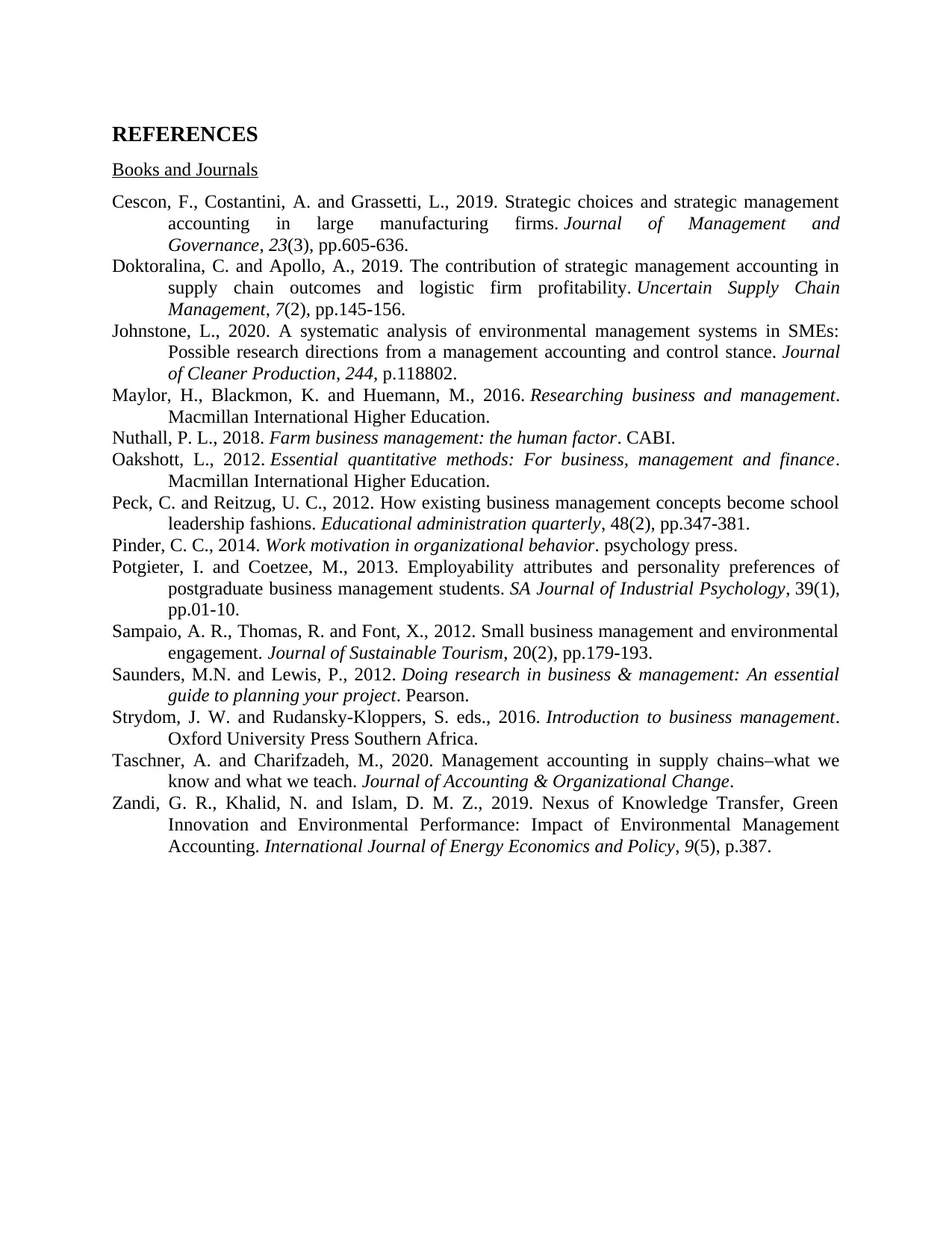
REFERENCES
Books and Journals
Cescon, F., Costantini, A. and Grassetti, L., 2019. Strategic choices and strategic management
accounting in large manufacturing firms. Journal of Management and
Governance, 23(3), pp.605-636.
Doktoralina, C. and Apollo, A., 2019. The contribution of strategic management accounting in
supply chain outcomes and logistic firm profitability. Uncertain Supply Chain
Management, 7(2), pp.145-156.
Johnstone, L., 2020. A systematic analysis of environmental management systems in SMEs:
Possible research directions from a management accounting and control stance. Journal
of Cleaner Production, 244, p.118802.
Maylor, H., Blackmon, K. and Huemann, M., 2016. Researching business and management.
Macmillan International Higher Education.
Nuthall, P. L., 2018. Farm business management: the human factor. CABI.
Oakshott, L., 2012. Essential quantitative methods: For business, management and finance.
Macmillan International Higher Education.
Peck, C. and Reitzug, U. C., 2012. How existing business management concepts become school
leadership fashions. Educational administration quarterly, 48(2), pp.347-381.
Pinder, C. C., 2014. Work motivation in organizational behavior. psychology press.
Potgieter, I. and Coetzee, M., 2013. Employability attributes and personality preferences of
postgraduate business management students. SA Journal of Industrial Psychology, 39(1),
pp.01-10.
Sampaio, A. R., Thomas, R. and Font, X., 2012. Small business management and environmental
engagement. Journal of Sustainable Tourism, 20(2), pp.179-193.
Saunders, M.N. and Lewis, P., 2012. Doing research in business & management: An essential
guide to planning your project. Pearson.
Strydom, J. W. and Rudansky-Kloppers, S. eds., 2016. Introduction to business management.
Oxford University Press Southern Africa.
Taschner, A. and Charifzadeh, M., 2020. Management accounting in supply chains–what we
know and what we teach. Journal of Accounting & Organizational Change.
Zandi, G. R., Khalid, N. and Islam, D. M. Z., 2019. Nexus of Knowledge Transfer, Green
Innovation and Environmental Performance: Impact of Environmental Management
Accounting. International Journal of Energy Economics and Policy, 9(5), p.387.
Books and Journals
Cescon, F., Costantini, A. and Grassetti, L., 2019. Strategic choices and strategic management
accounting in large manufacturing firms. Journal of Management and
Governance, 23(3), pp.605-636.
Doktoralina, C. and Apollo, A., 2019. The contribution of strategic management accounting in
supply chain outcomes and logistic firm profitability. Uncertain Supply Chain
Management, 7(2), pp.145-156.
Johnstone, L., 2020. A systematic analysis of environmental management systems in SMEs:
Possible research directions from a management accounting and control stance. Journal
of Cleaner Production, 244, p.118802.
Maylor, H., Blackmon, K. and Huemann, M., 2016. Researching business and management.
Macmillan International Higher Education.
Nuthall, P. L., 2018. Farm business management: the human factor. CABI.
Oakshott, L., 2012. Essential quantitative methods: For business, management and finance.
Macmillan International Higher Education.
Peck, C. and Reitzug, U. C., 2012. How existing business management concepts become school
leadership fashions. Educational administration quarterly, 48(2), pp.347-381.
Pinder, C. C., 2014. Work motivation in organizational behavior. psychology press.
Potgieter, I. and Coetzee, M., 2013. Employability attributes and personality preferences of
postgraduate business management students. SA Journal of Industrial Psychology, 39(1),
pp.01-10.
Sampaio, A. R., Thomas, R. and Font, X., 2012. Small business management and environmental
engagement. Journal of Sustainable Tourism, 20(2), pp.179-193.
Saunders, M.N. and Lewis, P., 2012. Doing research in business & management: An essential
guide to planning your project. Pearson.
Strydom, J. W. and Rudansky-Kloppers, S. eds., 2016. Introduction to business management.
Oxford University Press Southern Africa.
Taschner, A. and Charifzadeh, M., 2020. Management accounting in supply chains–what we
know and what we teach. Journal of Accounting & Organizational Change.
Zandi, G. R., Khalid, N. and Islam, D. M. Z., 2019. Nexus of Knowledge Transfer, Green
Innovation and Environmental Performance: Impact of Environmental Management
Accounting. International Journal of Energy Economics and Policy, 9(5), p.387.
1 out of 10
Related Documents
Your All-in-One AI-Powered Toolkit for Academic Success.
+13062052269
info@desklib.com
Available 24*7 on WhatsApp / Email
![[object Object]](/_next/static/media/star-bottom.7253800d.svg)
Unlock your academic potential
Copyright © 2020–2025 A2Z Services. All Rights Reserved. Developed and managed by ZUCOL.





